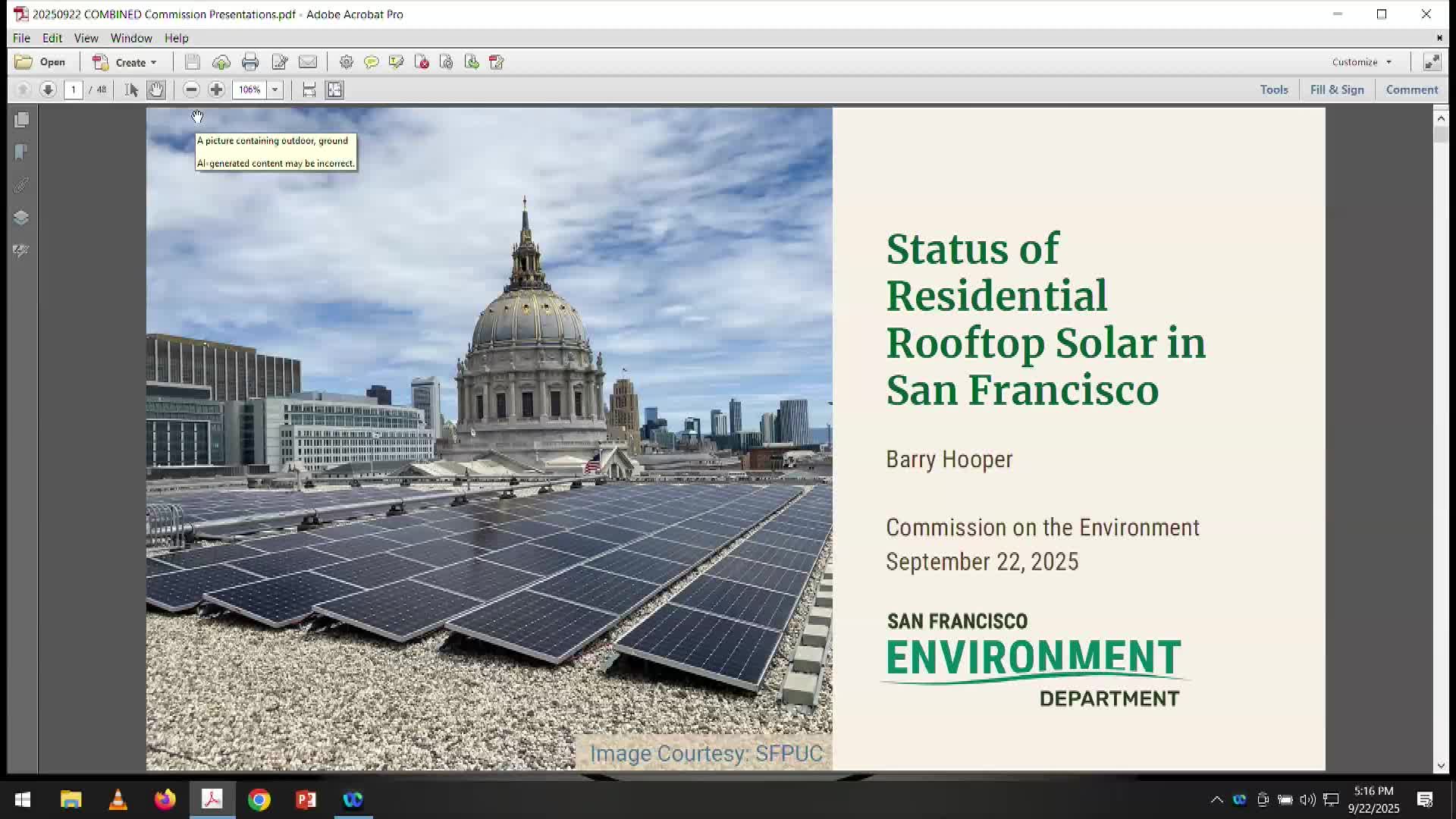San Francisco's IPM Program Proposes New Reduced Risk Pesticide List for 2025
September 22, 2025 | San Francisco City, San Francisco County, California
This article was created by AI summarizing key points discussed. AI makes mistakes, so for full details and context, please refer to the video of the full meeting. Please report any errors so we can fix them. Report an error »

In the heart of San Francisco, city officials gathered to discuss a pressing topic: the status of residential rooftop solar energy. As the meeting unfolded, the conversation illuminated the city's commitment to renewable energy and the strides made in solar adoption.
Currently, San Francisco boasts 50 megawatts of solar power installed on residential rooftops, generating approximately 6% of the energy consumed by homes. Additionally, commercial buildings contribute another 15 megawatts, accounting for about 1% of their energy use. This progress reflects a broader goal of transitioning to renewable energy sources, with the city’s electricity supplied by Clean Power SF, Hetch Hetchy Power, and PG&E—all of which are committed to zero greenhouse gas emissions by 2023.
The meeting highlighted the significant reduction in carbon emissions from the residential sector, which has seen a 50% decrease over the past 35 years. However, challenges remain, particularly with the reliance on natural gas. Officials emphasized that pairing rooftop solar with battery storage can enhance resilience during outages and natural disasters, while also reducing overall electricity costs.
Permitting for solar installations has evolved since the introduction of the first streamlining ordinance in 2012. While San Francisco has made strides in simplifying the process, including same-day permitting and mandatory solar in new constructions, there is still room for improvement. The recent state law, SB 379, mandates real-time online permitting for solar and battery storage, pushing the city to adapt its processes further.
Three pathways for obtaining solar permits were discussed: SolarAPP Plus for smaller systems, the new Solar Permit option for single-family and duplex homes, and the traditional PV plans for larger projects. Each option aims to facilitate the installation of solar energy systems while ensuring safety and compliance.
As the meeting concluded, officials pointed out an often-overlooked technology: thermal battery storage. This method utilizes heat pumps to store hot water, providing an effective means of energy storage without the fire risks associated with traditional batteries.
With these discussions, San Francisco continues to pave the way for a greener future, encouraging residents to embrace solar energy as a vital component of the city’s energy landscape. The journey toward a fully renewable energy grid is ongoing, but the commitment to innovation and sustainability remains strong.
Currently, San Francisco boasts 50 megawatts of solar power installed on residential rooftops, generating approximately 6% of the energy consumed by homes. Additionally, commercial buildings contribute another 15 megawatts, accounting for about 1% of their energy use. This progress reflects a broader goal of transitioning to renewable energy sources, with the city’s electricity supplied by Clean Power SF, Hetch Hetchy Power, and PG&E—all of which are committed to zero greenhouse gas emissions by 2023.
The meeting highlighted the significant reduction in carbon emissions from the residential sector, which has seen a 50% decrease over the past 35 years. However, challenges remain, particularly with the reliance on natural gas. Officials emphasized that pairing rooftop solar with battery storage can enhance resilience during outages and natural disasters, while also reducing overall electricity costs.
Permitting for solar installations has evolved since the introduction of the first streamlining ordinance in 2012. While San Francisco has made strides in simplifying the process, including same-day permitting and mandatory solar in new constructions, there is still room for improvement. The recent state law, SB 379, mandates real-time online permitting for solar and battery storage, pushing the city to adapt its processes further.
Three pathways for obtaining solar permits were discussed: SolarAPP Plus for smaller systems, the new Solar Permit option for single-family and duplex homes, and the traditional PV plans for larger projects. Each option aims to facilitate the installation of solar energy systems while ensuring safety and compliance.
As the meeting concluded, officials pointed out an often-overlooked technology: thermal battery storage. This method utilizes heat pumps to store hot water, providing an effective means of energy storage without the fire risks associated with traditional batteries.
With these discussions, San Francisco continues to pave the way for a greener future, encouraging residents to embrace solar energy as a vital component of the city’s energy landscape. The journey toward a fully renewable energy grid is ongoing, but the commitment to innovation and sustainability remains strong.
View full meeting
This article is based on a recent meeting—watch the full video and explore the complete transcript for deeper insights into the discussion.
View full meeting
